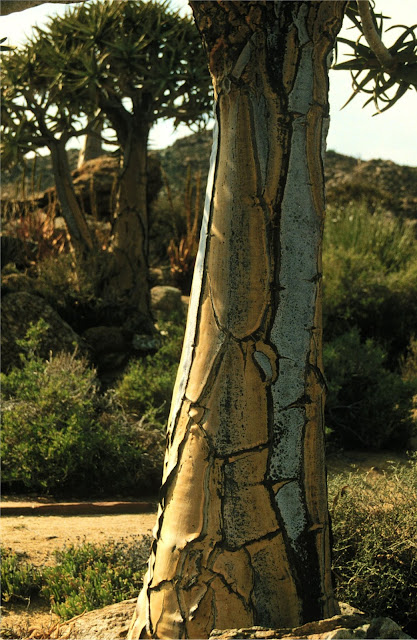I've spoken of this a number of times on this site, as succulents in general are a spectacular example of convergent evolution and the all-important process of adaptation. I've been retired for a number of years, but if were to go back into the biology classroom again today, I would walk up to the front and write ADAPTATION on the board (or powerpoint screen!). I would then proceed to show how everything we see in organisms is a result of this process, which unites genetics, ecology, evolution, and systematics.
Cacti and aloes have very different evolutionary histories leading to their convergence. In this post, I want to emphasize the historical dimension of adaptation. The current functional features of a plant have histories of gradual change, sometimes adding or improving functionality, sometimes changing the function altogether. Leaves themselves underwent extensive series of adaptations in early plants just to become the flat, efficient light-gathering antennae that we know today, and similar series of adaptations happened multiple times in different groups of plants. the very leafiness of leaves itself is convergent in true mosses, clubmosses, ferns, different groups of seed plants.
In various lineages of plants, leaves were further modified into the parts of gymnosperm cones, the parts of the flower and other reproductive structures. Leaves have also been modified through adaptation into grasping tendrils, sticky insect-catching traps, and other specialized structures. In cacti, leaves disappeared, or were converted into spines, as the stems adapted simultaneously for photosynthesis and water-storage. In aloes, leaves retained their photosynthetic function, while adding water storage.
Both cacti and aloes thus came from "normal" plants adapted for less arid conditions. Among the nearest non-succulent relatives of cacti are carnations, and of aloes they are daylilies, asparagus, and amaryllis. Cacti are eudicots, which typically have prominent stem systems and relatively small leaves. Aloes are monocots, which typically have condensed, inconspicuous, and mostly underground stems, but prominent, elongate leaves. It was "easier" for cacti to adapt their already exposed stems for water storage, but for aloes it was easier to add that function to their leaves, than to redesign their underground stems. So in adapting to new conditions, organisms modify what they already have, in the simplest way ("along the lines of least resistance").
So in considering the process of adaptation, we must keep in mind that organisms adapt to new or changing conditions by modifying pre-existing structures. Developing new organs from scratch happens rarely, if ever. In plants, stems and leaves have been the most plastic of organs, forming a wide variety of distinctive adaptive organs.
For some zoological examples, take the wings of birds. These highly specialized flight organs evolved from the front legs of their non-flying ancestors, radically changing their function. It happened separately in flying pterosaurs and in bats, using arm and hand bones differently. It did not end there with the birds, for wings went through another transformation in penguins, from flying organs to swimming organs. In snakes, legs disappeared altogether or remained as a set of tiny useless bones buried within their muscles, what we refer to as vestigial organs. The same thing happened in whales, where the front legs were modified into flippers, while the hind legs were reduced to buried vestigial structures. So one possible endpoint for a history of adaptations is to disappear!
Studying the history of adaptations in particular animals, or particular organs, is one of the most fascinating areas of biology, helping us understand the strange bedfellows resulting in modern classification (carnations and cacti, asparagus and aloes!), as well as the process of adaptation and the ecology of organisms. Proposed evolutionary scenarios must always include a plausible evolutionary (i.e. adaptive) history of how they came to be.
The aloes and some closely related genera, incidentally provide another opportunity for a theme and variations expedition like I did with the Amaryllis family a little while ago. These leafy succulents are native primarily to Africa, and here are some photos from my collection:
.JPG) |
| Close-up of an unidentified Aloe showing the emergence of new leaves in the center. |
 |
| Aloe (or Kumara) plicatilis is unusual in having its leaves arranged in a single plane. |
 |
| Aloe (or Gonialoe) variegata |
 |
| Aloe pictifolia |
 |
| Aloe dichotoma is a rare example of a monocot that becomes a tree through an unusual type of secondary growth. |







